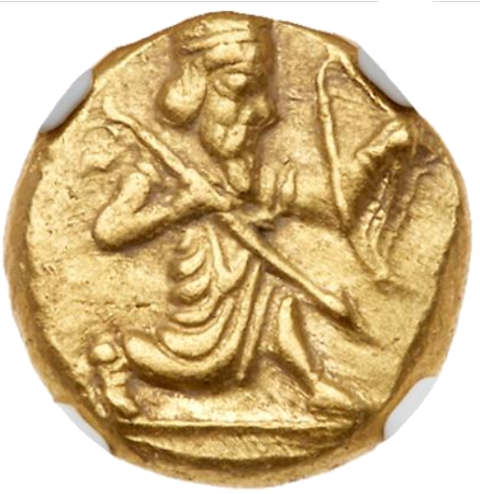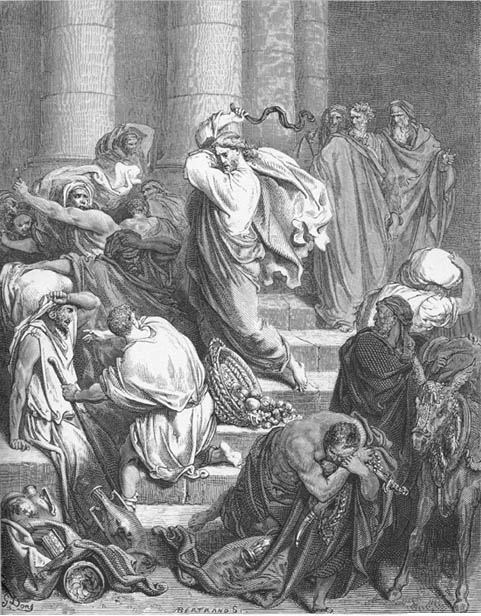The earliest coins to depict a real person, rather than a mythological figure, were also the first money mentioned in the Bible (and the only coins referred to in the Old Testament).
The Persian gold darics (named for King Darius) were issued almost unchanged in design from c. 521-330 BCE. The Persian king - Darius, Xerxes, Artaxerxes, et al - is shown running with a spear, sword and/or bow and arrow. Ezra 2:68-69 indicates that "some of the chief of the fathers, when they came to the house of the Lord which is at Jerusalem, offered freely for the house of God ... three score and one thousand drams (e.g. darics)." Similar silver siglos coins likely formed the "ten thousand talents of silver" (equal to approximately 90 million sigloi!) paid by Haman into "the king's (Ahasuerus = Artaxerxes?) treasuries" so that the king would destroy the Jews (Esther 2:9). (#3)


#3 - Persian Daric c. 420-375 BCE (H-Fig. 4.1)
Alexander the Great set out for Persia in 334 BCE at the head of an army of 35,000. He defeated Darius III and confiscated the Persian treasury. Alexander continued south, rapidly conquering the major Phoenician cities of Aradus, Sidon and Tyre. Continuing south along the coast, Akko surrendered without a fight, and Alexander captured Gaza in 332 BCE, after a two-month siege.
By Alexander's untimely death at the age of 32, the youthful ruler of the civilized world had established twenty major mints from Italy to Asia ... including one at Akko in Judaea. Their main outputs were large silver tetradrachms, featuring a handsome portrait of the god Hercules (some say it is actually Alexander); the reverse shows the god Zeus on a throne, surrounded by the Greek inscription "King Alexander." The tetradrachms produced at the Akko mint are of distinctive style - the portrait is rather crude and the year of striking (in Phoenician) is indicated. (#4)

#4 Alexander the Great tetradrachm, Akko mint (H-1090)
The silver shekels and half shekels issued by the Phoenician city of Tyre (c. 126 BCE - 66 CE) are perhaps the most significant of all Bible coins for both Jews and Christians. These coins, produced in large quantities, became the standard silver coinage in the Phoenician-Judaean area, replacing the coins of Alexander the Great. The obverse features the representation of Melkart (Baal), the chief diety of the Phoenicians. The reverse shows an Egyptian-style eagle with its right claw resting on a ship's rudder (referring to Tyre's port), a club (Melkart is associated with Hercules), and the Greek inscription "Tyre the Holy and Inviolable" and a date. The date consists of the number of years since the acknowledgment of Tyre's independence by Syria. (#5)

#5 Shekel of Tyre 90/89 BCE (H-1618)
The Jews had no silver coins of their own throughout the period of Tyrian shekels and half shekels. But all of the Judaean taxes were specified in shekels (e.g. the annual Temple Tax for males over 20 was specified as half a shekel). So the Temple Priests had to devise a practical solution. They decided that the Tyrian coins were plentiful and of good silver quality, and so they prescribed that the various Judaean taxes could be accepted only in Tyrian coins ... even though they went against prohibitions of the First Commandment: "You shall have no other gods beside Me. You shall not make for yourself a sculptured image or any likeness of what is in the heavens above, or on earth below, or in the waters under the earth." Much later, when "Jesus went into the temple of God, and ... overthrew the tables of the moneychangers" (Matthew 21:12), he was attacking those who exchanged Tyrian coins for others, detected counterfeits, etc.

Engraving by Gustave Doré
In addition, it was most likely a Shekel of Tyre that Jesus and Peter used to pay the Temple Tax (1/2 shekel each): "Go thou to the sea, and cast an hook, and take up the fish that first cometh up; and when thou hast opened his mouth, thou shalt find a piece of money. That take, and give unto them for me and thee" (Matthew 17:27). And finally, these coins probably made up the infamous payment to Judas, when "they covenanted with him for thirty pieces of silver" (Matthew 26:15).
Scholar Yaakov Meshorer has recently noted that "the Shekels of Tyre on which the inscription KP appears (18 BCE - 66 CE) have in most cases, an inferior style ... and the majority have been found in Israel." He proposes that Tyre must have discontinued these coins in 19 BCE, and Jewish authorities continued minting them in Jerusalem because they were the only coins acceptable for tax payments; the series came to an end at the outbreak of the First Revolt in 66 CE. Meshorer concludes by quoting Jewish commentaries (Tosephta Kethuboth 13:20): "Silver, whenever mentioned in the Pentateuch, is Tyrian silver. What is a Tyrian silver (coin)? It is a Jerusalemite." However this theory has not been unanimously accepted by experts. (#6)

# 6 Shekel of Tyre, Jerusalem Mint?, 33/34 CE (H-1620)
© 2020-Mel Wacks